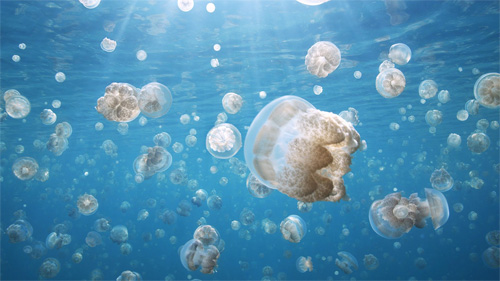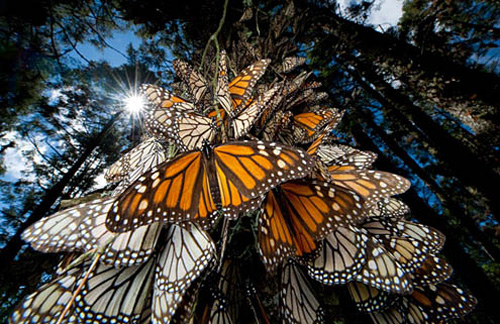This amazing National
Geographic special is currently being screened on Channel 9 and is also
available on DVD and Blu-ray through Madman. The documentary is
reminiscent of the excellent BBC Earth documentaries as it
showcases a plethora of amazing species. It should also be noted that
this series took over three years to produce and it is littered with
some of the most spectacular footage of animal migrations from around
the world. Before I get to the content of this review, I need to speak
about the video quality behind Great Migrations... wow... the video
quality of this release looks amazing, thanks to its 1080i presentation
that boasts some breathtaking scenes with ultra sharp images, vibrant
colours and deep blacks. Some of the close-ups are to die for,
especially the Monarch butterflies or the deadly crocodiles who attempt
to hunt the animals who dare cross their river.

At times, it's almost
like these animals are about to jump out of your TV screen and even the
close-ups of these animals is just gobsmacking as you see every
individual hair or bumps on these creatures. For example, the walrus
close-ups is like you can reach out and pull their whiskers and you see
every imperfection on their skin. For a documentary on migration that
hovers between life and death, Great Migrations is almost a living
breathing entity and could be considered a heirloom to future
generations.
Coming on two Blu-ray discs, Great Migrations collects all four episodes
from this series and includes an additional two bonus specials that are
equally as good. The episodes included in this release are Born to Move,
Need to Breed, Race to Survive & Feast or Famine which touches on a
variety of elements of the lives of various species from around the
world. The first episode Born to Move focuses on the aspects of
birth, life and death.

The highlight of this
episode were the monarch butterflies as we are given an insight into
their colourful and majestic yet short lives. From close-ups to
long-shots that show thousands of these butterflies moving, it was truly
a sensory overload and looked amazing on FULL HD.
The episode also
featured a very graphic scene that involved the wildebeests being
attacked by cheetahs and crocodiles which was actually quite disturbing
due to the high quality video footage. It almost brought a tear to my
eye because of how emotional it was. Therefore parents should be advised
that with younger children, they may need to monitor their viewing.
Another interesting part
of this episode were the ants from Costa Rico who demolish everything in
their path and Alex Baldwin throws in a great Star Trek reference
"resistance is futile!". I was also impressed to know that whales can
live beyond 70 years and one ageing whale would have swum around the
world more than 60 times in his life.
Following on is Need to Breed that focuses on the procreation and
parenting of animals. From birds to mammals and the some amazing rare
footage of the white-eared knob antelope, it's another powerful and
moving episode. Race to Survive focuses on the migration habits of the
Zebra as they make their move from deserts to grasslands.

Although there are other
animals in this episode, the main focus is on the Zebra and just like
episode one, there is another graphic scene involving crocodiles and
Zebra. It's also quite baffling to the mind that with all the places to
cross, these Zebras decide to cross where there is a huge population of
crocodiles. Nonetheless, Race to Survive once again features some
amazing footage of not only the animals but also that of planet earth.
The final episode is Feast or Famine and focuses on the food sources for
various species around the world and how their migration patterns are
influenced by their hunt for nutrients. The highlight of this episode
are the African Elephants in the Sahara desert and with so many other
fertile areas near this region, it's quite amazing to watch their
journey unfold as they search for food and a place for their young to
grow.
Apart from land dwelling
creatures, Feast or Famine also showcases the underwater variety from
sharks to jellyfish which are just as insightful. Given the diverse cast
(e.g. the animals) of Great Migrations, National Geographic have done a
commendable job at not only making it a visual treat but ensuring that
the information is accessible to all. It does help that Alex Baldwin is
the voice behind this series who portrays a sense of wonder and majesty.
My only one gripe about this series is that sometimes it uses footage
seen in previous episodes but this is only now and then. It's the only
issue I could find about this entire collection.

Audio & Special
Features
The audio quality of
Great Migrations supports a lossless surround track with a DTS-HS Master
Audio 5.1 format. There's some great use of the channels in this
documentary and everything sounds crystal clear. At times, there is so
much happening at once that it's almost like you are in the jungle or in
the Sahara desert. The most amazing aspect of the audio are the smaller
creatures such as the Monarch butterflies as you actually hear the
powerful flaps of their wings or the red bats from Australia.
In terms of special
features, Great Migrations comes with The Science of Migrations and
Behind the Scenes of Great Migrations. The Science of Migrations goes
into the process of how the scientists through research and technology
followed these animals on this powerful journey. Behind the Scenes of
'Great Migrations' on the other hand focuses more on the filming of this
documentary and how they achieved some of these amazing shots,
especially the close-ups. Both are a must watch special feature.
Conclusion
In the end, Great Migrations is easily one of the best documentary
series produced and if you are a Blu-ray owner, this is the definitive
version to have. It's produced on the same calibre as the BBC series
Planet Earth and looks visually stunning thanks to its 1080i
presentation. Sound is equally impressive as is the content of this
documentary. Highly Recommended!